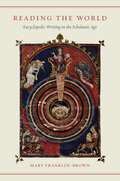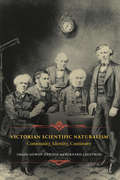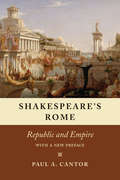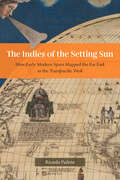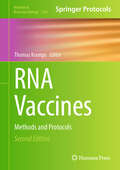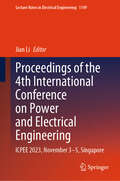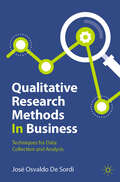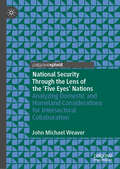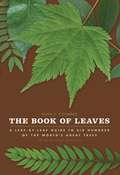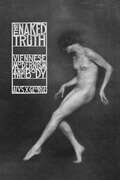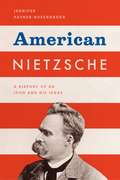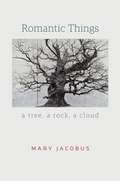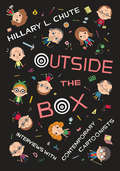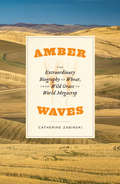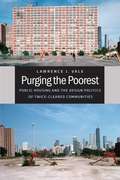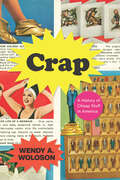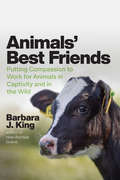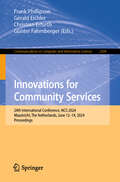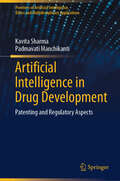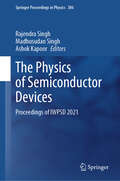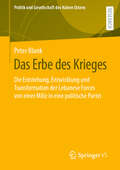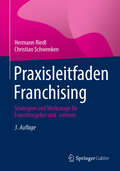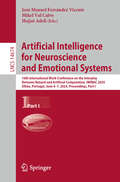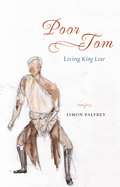- Table View
- List View
Reading the World: Encyclopedic Writing in the Scholastic Age
by Mary Franklin-BrownThe thirteenth century saw such a proliferation of new encyclopedic texts that more than one scholar has called it the “century of the encyclopedias.” Variously referred to as a speculum, thesaurus, or imago mundi—the term encyclopedia was not commonly applied to such books until the eighteenth century—these texts were organized in such a way that a reader could easily locate a collection of authoritative statements on any given topic. Because they reproduced, rather than simply summarized, parts of prior texts, these compilations became libraries in miniature. In this groundbreaking study, Mary Franklin-Brown examines writings in Latin, Catalan, and French that are connected to the encyclopedic movement: Vincent of Beauvais’s Speculum maius; Ramon Llull’s Libre de meravelles, Arbor scientiae, and Arbre de filosofia d’amor; and Jean de Meun’s continuation of the Roman de la Rose. Franklin-Brown analyzes the order of knowledge in these challenging texts, describing the wide-ranging interests, the textual practices—including commentary, compilation, and organization—and the diverse discourses that they absorb from preexisting classical, patristic, and medieval writing. She also demonstrates how these encyclopedias, like libraries, became “heterotopias” of knowledge—spaces where many possible ways of knowing are juxtaposed. But Franklin-Brown’s study will not appeal only to historians: she argues that a revised understanding of late medievalism makes it possible to discern a close connection between scholasticism and contemporary imaginative literature. She shows how encyclopedists employed the same practices of figuration, narrative, and citation as poets and romanciers, while much of the difficulty of the imaginative writing of this period derives from a juxtaposition of heterogeneous discourses inspired by encyclopedias. With rich and innovative readings of texts both familiar and neglected, Reading the World reveals how the study of encyclopedism can illuminate both the intellectual work and the imaginative writing of the scholastic age.
Victorian Scientific Naturalism: Community, Identity, Continuity
by Edited by Gowan Dawson and Bernard LightmanVictorian Scientific Naturalism examines the secular creeds of the generation of intellectuals who, in the wake of The Origin of Species, wrested cultural authority from the old Anglican establishment while installing themselves as a new professional scientific elite. These scientific naturalists—led by biologists, physicists, and mathematicians such as William Kingdon Clifford, Joseph Dalton Hooker, Thomas Henry Huxley, and John Tyndall—sought to persuade both the state and the public that scientists, not theologians, should be granted cultural authority, since their expertise gave them special insight into society, politics, and even ethics. In Victorian Scientific Naturalism, Gowan Dawson and Bernard Lightman bring together new essays by leading historians of science and literary critics that recall these scientific naturalists, in light of recent scholarship that has tended to sideline them, and that reevaluate their place in the broader landscape of nineteenth-century Britain. Ranging in topic from daring climbing expeditions in the Alps to the maintenance of aristocratic protocols of conduct at Kew Gardens, these essays offer a series of new perspectives on Victorian scientific naturalism—as well as its subsequent incarnations in the early twentieth century—that together provide an innovative understanding of the movement centering on the issues of community, identity, and continuity.
Shakespeare's Rome: Republic and Empire
by Paul A. CantorFor more than forty years, Paul Cantor’s Shakespeare’s Rome has been a foundational work in the field of politics and literature. While many critics assumed that the Roman plays do not reflect any special knowledge of Rome, Cantor was one of the first to argue that they are grounded in a profound understanding of the Roman regime and its changes over time. Taking Shakespeare seriously as a political thinker, Cantor suggests that his Roman plays can be profitably studied in the context of the classical republican tradition in political philosophy. In Shakespeare’s Rome, Cantor examines the political settings of Shakespeare’s Roman plays, Coriolanus and Antony and Cleopatra, with references as well to Julius Caesar. Cantor shows that Shakespeare presents a convincing portrait of Rome in different eras of its history, contrasting the austere republic of Coriolanus, with its narrow horizons and martial virtues, and the cosmopolitan empire of Antony and Cleopatra, with its “immortal longings” and sophistication bordering on decadence.
The Indies of the Setting Sun: How Early Modern Spain Mapped the Far East as the Transpacific West
by Ricardo PadrónPadrón reveals the evolution of Spain’s imagining of the New World as a space in continuity with Asia. Narratives of Europe’s westward expansion often tell of how the Americas came to be known as a distinct landmass, separate from Asia and uniquely positioned as new ground ripe for transatlantic colonialism. But this geographic vision of the Americas was not shared by all Europeans. While some imperialists imagined North and Central America as undiscovered land, the Spanish pushed to define the New World as part of a larger and eminently flexible geography that they called las Indias, and that by right, belonged to the Crown of Castile and León. Las Indias included all of the New World as well as East and Southeast Asia, although Spain’s understanding of the relationship between the two areas changed as the realities of the Pacific Rim came into sharper focus. At first, the Spanish insisted that North and Central America were an extension of the continent of Asia. Eventually, they came to understand East and Southeast Asia as a transpacific extension of their empire in America called las Indias del poniente, or the Indies of the Setting Sun.The Indies of the Setting Sun charts the Spanish vision of a transpacific imperial expanse, beginning with Balboa’s discovery of the South Sea and ending almost a hundred years later with Spain’s final push for control of the Pacific. Padrón traces a series of attempts—both cartographic and discursive—to map the space from Mexico to Malacca, revealing the geopolitical imaginations at play in the quest for control of the New World and Asia.
RNA Vaccines: Methods and Protocols (Methods in Molecular Biology #2786)
by Thomas KrampsThis second edition volume expands on the previous edition with discussions of the latest technology and advancements in the development of RNA vaccines and proposed solutions on how to tackle currently unmet medical needs. The chapters in this book are organized into four parts and cover topics such as replication and non-replicating RNA vectors, formulation and delivery of RNA vaccines, and clinical and nonclinical development of RNA vaccines. Written in the highly successful Methods in Molecular Biology series format, chapters include introductions to their respective topics, lists of the necessary materials and reagents, step-by-step, readily reproducible laboratory protocols, and tips on troubleshooting and avoiding known pitfalls.Practical and comprehensive, RNA Vaccines: Methods and Protocols, Second Edition is a valuable resource for any researcher interested in learning more about this important and developing field.
Proceedings of the 4th International Conference on Power and Electrical Engineering: ICPEE 2023, November 3–5, Singapore (Lecture Notes in Electrical Engineering #1149)
by Jian LiThis book features a collection of carefully selected papers that were presented at the 4th International Conference on Power and Electrical Engineering, ICPEE 2023. The conference was held in Singapore from November 3-5, 2023, and focused on the latest advancements and technologies in the field of power and electrical engineering. The papers included in this book highlight the need for sustainable and efficient energy sources, as well as the development of new technologies such as smart grids, renewable energy systems, and energy storage systems. They also address the challenges and opportunities faced by power and electrical engineers due to the increasing use of electric vehicles and the integration of renewable energy sources into power grids. The papers are authored by an international group of academics, research scientists, and industry experts, making the book valuable to a global audience in the field of power engineering.
Qualitative Research Methods In Business: Techniques for Data Collection and Analysis
by José Osvaldo De SordiThe challenges of developing research and generating scientific knowledge in environments that involve subjective aspects related to employees, customers, managers, leaders, inspectors, auditors, among other stakeholders in the business environment, can be overwhelming for students that are new to this type of inquiry. This textbook presents an integrated view of qualitative research strategies with data collection and analysis techniques.The book explores nine distinct research strategies, namely ethnography, phenomenology, grounded theory, case study, design science research, grounded design, action research, participatory action research, and action-design research.Related to data collection, this text discusses different types of qualitative interviews (focus groups, ethnographic, phenomenological, etc), as well as how to handle ethical issues that may arise.In terms of analyzing data, the author describes various reading techniques, how to code the text, and how to use software to aid in the analysis.The final section of the book explains how to write up the results of qualitative research, including article structure and selecting an outlet for publication.Students will benefit from the plentiful examples and exercises that highlight the interweaving of data collection and analysis as well as concrete guidelines on engaging in qualitative research. At a time in which qualitative research is becoming more rigorous to meet the demands of the field, this textbook will prove a valuable resource for the next generation of business researchers.The English translation of this book from its Portuguese original manuscript was done with the help of artificial intelligence (machine translation by the service provider DeepL.com). A subsequent human revision of the content was done by the author.
National Security Through the Lens of the ‘Five Eyes’ Nations: Analyzing Domestic and Homeland Considerations for Intersectoral Collaboration
by John Michael WeaverThis book analyzes the ‘Five Eyes’ nations’ concerns and policies relating to national security threats through an interdisciplinary theoretical engagement with the Political, Information, Security and Economic (PISE) Model. Through the analysis of secondary data sources such as scholarly and government reports, policy documents, press releases and interviews, the author analyzes the five case studies—Australia, Canada, New Zealand, UK, and the USA—to determine how and why nations use the PISE variables to shape favorable homeland security outcomes, to determine what the points of homeland intersectoral collaboration are among the ‘Five Eyes’ nations. In so doing, Weaver determines that although the ‘Five Eyes’ countries have concerns about homeland security and each, individually, identifies threats and hazards, they do also employ collaborative measures to build resilience and increase efforts to prepare for anticipated security breaches.
Seeds: A Natural History
by Carolyn FryFrom the magnificence of a towering redwood to the simple elegance of a tiny dandelion, seed-bearing plants abound on planet Earth. The sheer diversity of plants thriving today is largely thanks to the evolution of the seed, as this made plants resilient to environmental changes by enabling them to await optimum conditions for growth before springing to life. In a time of declining biodiversity, studying seeds is now helping scientists preserve this plant diversity for future generations. With Seeds, Carolyn Fry offers a celebration of these vital but unassuming packages of life. She begins with a sweeping tour through human history, designed to help us understand why we should appreciate and respect these floral parcels. Wheat, corn, and rice, she reminds us, supply the foundations of meals eaten by people around the world. Countless medicines, oils, clothing materials, and building supplies are available only because of the versatility and variety of seed-bearing plants. Fry then provides a comprehensive history of the evolution of seeds, explaining the myriad ways that they have adapted, survived, and thrived across the globe. Delving deeper into the science of seeds, she reveals the fascinating processes of dormancy, reproduction, germination, and dispersal, and showcases the estimable work conservationists are doing today to gather and bank seeds in order to prevent species from going extinct. Enriched by a stunning array of full-color images, Seeds offers a comprehensive exploration of some of the most enduring and essential players in the natural world.
The Book of Leaves: Leaf-by-Leaf Guide to Six Hundred of the World's Great Trees
by Allen J. CoombesOf all our childhood memories, few are quite as thrilling, or as tactile, as those of climbing trees. Scampering up the rough trunk, spying on the world from the cool green shelter of the canopy, lying on a limb and looking up through the leaves at the summer sun almost made it seem as if we were made for trees, and trees for us.Even in adulthood, trees retain their power, from the refreshing way their waves of green break the monotony of a cityscape to the way their autumn transformations take our breath away. In this lavishly illustrated volume, the trees that have enriched our lives finally get their full due, through a focus on the humble leaves that serve, in a sense, as their public face. The Book of Leaves offers a visually stunning and scientifically engaging guide to six hundred of the most impressive and beautiful leaves from around the world. Each leaf is reproduced here at its actual size, in full color, and is accompanied by an explanation of the range, distribution, abundance, and habitat of the tree on which it’s found. Brief scientific and historical accounts of each tree and related species include fun-filled facts and anecdotes that broaden its portrait. The Henry’s Maple, for instance, found in China and named for an Irish doctor who collected leaves there, bears little initial resemblance to the statuesque maples of North America, from its diminutive stature to its unusual trifoliolate leaves. Or the Mediterranean Olive, which has been known to live for more than 1,500 years and whose short, narrow leaves only fall after two or three years, pushed out in stages by the emergence of younger leaves. From the familiar friends of our backyards to the giants of deep woods, The Book of Leaves brings the forest to life—and to our living rooms—as never before.
The Naked Truth: Viennese Modernism and the Body
by Alys X. GeorgeUncovers the interplay of the physical and the aesthetic that shaped Viennese modernism and offers a new interpretation of this moment in the history of the West. Viennese modernism is often described in terms of a fin-de-siècle fascination with the psyche. But this stereotype of the movement as essentially cerebral overlooks a rich cultural history of the body. The Naked Truth, an interdisciplinary tour de force, addresses this lacuna, fundamentally recasting the visual, literary, and performative cultures of Viennese modernism through an innovative focus on the corporeal. Alys X. George explores the modernist focus on the flesh by turning our attention to the second Vienna medical school, which revolutionized the field of anatomy in the 1800s. As she traces the results of this materialist influence across a broad range of cultural forms—exhibitions, literature, portraiture, dance, film, and more—George brings into dialogue a diverse group of historical protagonists, from canonical figures such as Egon Schiele, Arthur Schnitzler, Joseph Roth, and Hugo von Hofmannsthal to long-overlooked ones, including author and doctor Marie Pappenheim, journalist Else Feldmann, and dancers Grete Wiesenthal, Gertrud Bodenwieser, and Hilde Holger. She deftly blends analyses of popular and “high” culture, laying to rest the notion that Viennese modernism was an exclusively male movement. The Naked Truth uncovers the complex interplay of the physical and the aesthetic that shaped modernism and offers a striking new interpretation of this fascinating moment in the history of the West.
American Nietzsche: A History of an Icon and His Ideas
by Jennifer Ratner-RosenhagenIf you were looking for a philosopher likely to appeal to Americans, Friedrich Nietzsche would be far from your first choice. After all, in his blazing career, Nietzsche took aim at nearly all the foundations of modern American life: Christian morality, the Enlightenment faith in reason, and the idea of human equality. Despite that, for more than a century Nietzsche has been a hugely popular—and surprisingly influential—figure in American thought and culture. In American Nietzsche, Jennifer Ratner-Rosenhagen delves deeply into Nietzsche's philosophy, and America’s reception of it, to tell the story of his curious appeal. Beginning her account with Ralph Waldo Emerson, whom the seventeen-year-old Nietzsche read fervently, she shows how Nietzsche’s ideas first burst on American shores at the turn of the twentieth century, and how they continued alternately to invigorate and to shock Americans for the century to come. She also delineates the broader intellectual and cultural contexts within which a wide array of commentators—academic and armchair philosophers, theologians and atheists, romantic poets and hard-nosed empiricists, and political ideologues and apostates from the Left and the Right—drew insight and inspiration from Nietzsche’s claims for the death of God, his challenge to universal truth, and his insistence on the interpretive nature of all human thought and beliefs. At the same time, she explores how his image as an iconoclastic immoralist was put to work in American popular culture, making Nietzsche an unlikely posthumous celebrity capable of inspiring both teenagers and scholars alike. A penetrating examination of a powerful but little-explored undercurrent of twentieth-century American thought and culture, American Nietzsche dramatically recasts our understanding of American intellectual life—and puts Nietzsche squarely at its heart.
Romantic Things: A Tree, A Rock, A Cloud
by Mary JacobusOur thoughts are shaped as much by what things make of us as by what we make of them. Lyric poetry is especially concerned with things and their relationship to thought, sense, and understanding. In Romantic Things, Mary Jacobus explores the world of objects and phenomena in nature as expressed in Romantic poetry alongside the theme of sentience and sensory deprivation in literature and art. Jacobus discusses objects and attributes that test our perceptions and preoccupy both Romantic poetry and modern philosophy. John Clare, John Constable, Rainer Maria Rilke, W. G. Sebald, and Gerhard Richter make appearances around the central figure of William Wordsworth as Jacobus explores trees, rocks, clouds, breath, sleep, deafness, and blindness in their work. While she thinks through these things, she is assisted by the writings of Maurice Merleau-Ponty, Jacques Derrida, and Jean-Luc Nancy. Helping us think more deeply about things that are at once visible and invisible, seen and unseen, felt and unfeeling, Romantic Things opens our eyes to what has been previously overlooked in lyric and Romantic poetry.
Outside the Box: Interviews with Contemporary Cartoonists
by Hillary L. ChuteWe are living in a golden age of cartoon art. Never before has graphic storytelling been so prominent or garnered such respect: critics and readers alike agree that contemporary cartoonists are creating some of the most innovative and exciting work in all the arts. For nearly a decade Hillary L. Chute has been sitting down for extensive interviews with the leading figures in comics, and with Outside the Box she offers fans a chance to share her ringside seat. Chute’s in-depth discussions with twelve of the most prominent and accomplished artists and writers in comics today reveal a creative community that is richly interconnected yet fiercely independent, its members sharing many interests and approaches while working with wildly different styles and themes. Chute’s subjects run the gamut of contemporary comics practice, from underground pioneers like Art Spiegelman and Lynda Barry, to the analytic work of Scott McCloud, the journalism of Joe Sacco, and the extended narratives of Alison Bechdel, Charles Burns, and more. They reflect on their experience and innovations, the influence of peers and mentors, the reception of their art and the growth of critical attention, and the crucial place of print amid the encroachment of the digital age. Beautifully illustrated in full-color, and featuring three never-before-published interviews—including the first published conversation between Art Spiegelman and Chris Ware—Outside the Box will be a landmark volume, a close-up account of the rise of graphic storytelling and a testament to its vibrant creativity.
Amber Waves: The Extraordinary Biography of Wheat, from Wild Grass to World Megacrop
by Catherine ZabinskiA biography of a staple grain we often take for granted, exploring how wheat went from wild grass to a world-shaping crop. At breakfast tables and bakeries, we take for granted a grain that has made human civilization possible, a cereal whose humble origins belie its world-shaping power: wheat. Amber Waves tells the story of a group of grass species that first grew in scattered stands in the foothills of the Middle East until our ancestors discovered their value as a source of food. Over thousands of years, we moved their seeds to all but the polar regions of Earth, slowly cultivating what we now know as wheat, and in the process creating a world of cuisines that uses wheat seeds as a staple food. Wheat spread across the globe, but as ecologist Catherine Zabinski shows us, a biography of wheat is not only the story of how plants ensure their own success: from the earliest bread to the most mouthwatering pasta, it is also a story of human ingenuity in producing enough food for ourselves and our communities. Since the first harvest of the ancient grain, we have perfected our farming systems to grow massive quantities of food, producing one of our species’ global mega crops—but at a great cost to ecological systems. And despite our vast capacity to grow food, we face problems with undernourishment both close to home and around the world. Weaving together history, evolution, and ecology, Zabinski’s tale explores much more than the wild roots and rise of a now-ubiquitous grain: it illuminates our complex relationship with our crops, both how we have transformed the plant species we use as food, and how our society—our culture—has changed in response to the need to secure food sources. From the origins of agriculture to gluten sensitivities, from our first selection of the largest seeds from wheat’s wild progenitors to the sequencing of the wheat genome and genetic engineering, Amber Waves sheds new light on how we grow the food that sustains so much human life.
Purging the Poorest: Public Housing and the Design Politics of Twice-Cleared Communities (Historical Studies Of Urban America Ser.)
by Lawrence J. ValeThe building and management of public housing is often seen as a signal failure of American public policy, but this is a vastly oversimplified view. In Purging the Poorest, Lawrence J. Vale offers a new narrative of the seventy-five-year struggle to house the “deserving poor.”In the 1930s, two iconic American cities, Atlanta and Chicago, demolished their slums and established some of this country’s first public housing. Six decades later, these same cities also led the way in clearing public housing itself. Vale’s groundbreaking history of these “twice-cleared” communities provides unprecedented detail about the development, decline, and redevelopment of two of America’s most famous housing projects: Chicago’s Cabrini-Green and Atlanta’s Techwood /Clark Howell Homes. Vale offers the novel concept of design politics to show how issues of architecture and urbanism are intimately bound up in thinking about policy. Drawing from extensive archival research and in-depth interviews, Vale recalibrates the larger cultural role of public housing, revalues the contributions of public housing residents, and reconsiders the role of design and designers.
Crap: A History of Cheap Stuff in America
by Wendy A. WolosonCrap. We all have it. Filling drawers. Overflowing bins and baskets. Proudly displayed or stuffed in boxes in basements and garages. Big and small. Metal, fabric, and a whole lot of plastic. So much crap. Abundant cheap stuff is about as American as it gets. And it turns out these seemingly unimportant consumer goods offer unique insights into ourselves—our values and our desires. In Crap: A History of Cheap Stuff in America, Wendy A. Woloson takes seriously the history of objects that are often cynically-made and easy to dismiss: things not made to last; things we don't really need; things we often don't even really want. Woloson does not mock these ordinary, everyday possessions but seeks to understand them as a way to understand aspects of ourselves, socially, culturally, and economically: Why do we—as individuals and as a culture—possess these things? Where do they come from? Why do we want them? And what is the true cost of owning them? Woloson tells the history of crap from the late eighteenth century up through today, exploring its many categories: gadgets, knickknacks, novelty goods, mass-produced collectibles, giftware, variety store merchandise. As Woloson shows, not all crap is crappy in the same way—bric-a-brac is crappy in a different way from, say, advertising giveaways, which are differently crappy from commemorative plates. Taking on the full brilliant and depressing array of crappy material goods, the book explores the overlooked corners of the American market and mindset, revealing the complexity of our relationship with commodity culture over time. By studying crap rather than finely made material objects, Woloson shows us a new way to truly understand ourselves, our national character, and our collective psyche. For all its problems, and despite its disposability, our crap is us.
Animals' Best Friends: Putting Compassion to Work for Animals in Captivity and in the Wild
by Barbara J. King“King’s Animals’ Best Friends is the most comprehensive exploration I’ve read of the complex relationship between the human and nonhuman, full of great insights and practical information.”—Jeff VanderMeer, New York Times Book Review, “By the Book”Finalist for the 2021 Siskiyou Prize for New Environmental Literature As people come to understand more about animals’ inner lives—the intricacies of their thoughts and the emotions that are expressed every day by whales and cows, octopus and mice, even bees—we feel a growing compassion, a desire to better their lives. But how do we translate this compassion into helping other creatures, both those that are and are not our pets? Bringing together the latest science with heartfelt storytelling, Animals’ Best Friends reveals the opportunities we have in everyday life to help animals in our homes, in the wild, in zoos, and in science labs, as well as those considered to be food. Barbara J. King, an expert on animal cognition and emotion, guides us on a journey both animal and deeply human. We meet cows living relaxed lives in an animal sanctuary—and cows with plastic portals in their sides at a university research station. We observe bison free-roaming at Yellowstone National Park and chimpanzees confined to zoos. We learn with King how to negotiate vegetarian preferences in omnivore restaurants. We experience the touch of a giant Pacific octopus tasting King’s skin with one of his long, neuron-rich arms. We reflect on animal testing as King shares her own experience as the survivor of a particularly nasty cancer. And in a moment all too familiar to many of us, we recover from a close encounter with two spiders in the home. This is a book not of shaming and limitation, but of uplift and expansion. Throughout this journey, King makes no claims of personal perfection. Though an animal expert, she is just like the rest of us: on a journey still, learning each day how to be better, and do better, for animals. But as Animals’ Best Friends makes clear, challenging choices can bring deep rewards. By turning compassion into action on behalf of animals, we not only improve animals’ lives—we also immeasurably enrich our own.
Innovations for Community Services: 24th International Conference, I4CS 2024, Maastricht, The Netherlands, June 12–14, 2024, Proceedings (Communications in Computer and Information Science #2109)
by Günter Fahrnberger Gerald Eichler Christian Erfurth Frank PhillipsonThis book constitutes the refereed proceedings of the 24th International Conference on Innovations for Community Services, I4CS 2024, held in Maastricht, The Netherlands, during June 12–14, 2024. The 17 full papers and 5 short papers presented in this book were carefully reviewed and selected from 44 submissions. They cover a variety of topics, including Quantum Computing, Pervasive Computing, Information Analysis, Graphs and Routing, Secure Applications, Information Security in Supply Chains, Blockchain and Digital Sovereignty.
Artificial Intelligence in Drug Development: Patenting and Regulatory Aspects (Frontiers of Artificial Intelligence, Ethics and Multidisciplinary Applications)
by Kavita Sharma Padmavati ManchikantiThis book discusses how Artificial Intelligence developments have revolutionized the area of medicine and how companies use them to develop applications. While the book covers the growth of AI in medicine and the early developments in AI based medical tools, it provides an in-depth analysis of the current developments in relation to the area of medical diagnostics. The book focuses on how enterprises and institutes have developed their intellectual property portfolio, particularly patents, in this area. Cross-country patenting analysis helps in understanding key areas of growth in certain markets and also company strategies and arrangements. The introduction of AI based products in market is subject to regulation. The developments in policy and regulation influence the development and deployment of such products into the market. This book brings focus to the development of policy and regulation and how regulatory developments impact the introduction of AI-based healthcare products from a cross-country perspective. Further, how regulatory developments lead to the evolution of standards, build reliability and safety in this area are also examined. The unique aspect of this book is the comprehensive coverage of the dual aspects of the nature and scope of AI-based innovations in health care and the related drug regulatory aspects which are imperative for the understanding for students, researchers, and those who work in this area.
The Physics of Semiconductor Devices: Proceedings of IWPSD 2021 (Springer Proceedings in Physics #306)
by Rajendra Singh Madhusudan Singh Ashok KapoorThis book includes proceedings of the 21st International Workshop on Physics of Semiconductor Devices. The workshop is jointly organized by the Indian Institute of Technology, Delhi, and Solid State Physics Laboratory, Delhi, in collaboration with the Society for Semiconductor Devices and Semiconductor Society of India. This book disseminates the current knowledge of semiconductor physics and its applications across the scientific community. It is based on a biennial workshop that provides the participating research groups with a stimulating platform for interaction and collaboration with colleagues from the same scientific community. The book discusses the latest developments in III-nitrides; materials and devices, compound semiconductors, VLSI technology, optoelectronics, sensors, photovoltaics, crystal growth, epitaxy, and characterization, graphene, and other 2D materials and organic semiconductors. The research articles included in this book are contributed by various eminent scientists from all over the world. The book serves as a reference resource for researchers and practitioners in academia and industry.
Das Erbe des Krieges: Die Entstehung, Entwicklung und Transformation der Lebanese Forces von einer Miliz in eine politische Partei (Politik und Gesellschaft des Nahen Ostens)
by Peter BlankDas vorliegende Buch untersucht die Entstehung und Entwicklung der Lebanese Forces als Miliz im libanesischen Bürgerkrieg (1975-1990) und ihre Transformation in eine politische Partei nach dem Ende des Krieges bis in die heutige Zeit. Als eine der wichtigsten Parteien des Landes spiegelt die Entwicklung der Lebanese Forces die wechselhafte Geschichte des Libanons seit dem Bürgerkrieg wider. Durch die Untersuchung der Organisationsstrukturen sowie von Mitgliederprofilen und Ideologie werden die Kontinuitäten und Diskontinuitäten der Parteigeschichte in ihrem historischen Kontext sichtbar gemacht und aufgezeigt, wie das Erbe des Krieges die politischen und gesellschaftlichen Entwicklungen des Libanons auch Jahrzehnte nach dem Ende der Gewalt prägt.
Praxisleitfaden Franchising: Strategien und Werkzeuge für Franchisegeber und -nehmer
by Hermann Riedl Christian SchwenkenFranchisesysteme verstehen, systematisch aufbauen und für alle Beteiligten zum Erfolg machen ist ein komplexes Unterfangen. Wie das geht, erfahren Sie in diesem Buch. Franchisegeber wie auch Franchisenehmer erhalten wertvolle Strategien und Tools für das Tagesgeschäft und Antworten auf grundlegende Fragen: Wie können verschiedene Franchisesysteme aus den unterschiedlichsten Perspektiven bewertet werden? Welche Rolle spielen Regelwerke und deren Inhalte dabei? Wie funktionieren die verschiedenen Prozesse und wie kann die Zusammenarbeit erfolgreich verlaufen? Wie können Marketingmaßnahmen im Franchisesystem gesteuert werden?Die Autoren liefern wertvolle und direkt in den Arbeitsalltag integrierbare Werkzeuge und Mustervorlagen u. a. zu Mitbewerberanalysen, Dienstplänen, Personalaudits, Tages- und Umsatzplanungen. Die dritte Auflage wurde überarbeitet und um aktuelle Veränderungen in der Rechtsprechung sowie die Themen Lizenzvertrag versus Franchisevertrag, Gebietsschutz und Scheinselbstständigkeit ergänzt.Ein unverzichtbarer Leitfaden für alle, die praxisnahe Informationen zum Thema Franchising suchen und sofort anwenden wollen.
Artificial Intelligence for Neuroscience and Emotional Systems: 10th International Work-Conference on the Interplay Between Natural and Artificial Computation, IWINAC 2024, Olhâo, Portugal, June 4–7, 2024, Proceedings, Part I (Lecture Notes in Computer Science #14674)
by Hojjat Adeli José Manuel Ferrández Vicente Mikel Val CalvoThe two volume set LNCS 14674 and 14675 constitutes the proceedings of the 10th International Work-Conference on the Interplay Between Natural and Artificial Computation, IWINAC 2024, which took place in Olhâo, Portugal, during June 4–7, 2024. The 99 full papers presented in these proceedings were carefully reviewed and selected from 193 submissions. They were organized in topical sections as follows: Part I: Machine learning in neuroscience; artificial intelligence in neurophysiology; neuromotor and cognitive disorders; intelligent systems for assessment, treatment, and assistance in early stages of Alzheimer's disease and other dementias; socio-cognitive, affective and physiological computing; affective computing and context awareness in ambientintelliigence; learning tools to lecture; Part II: Machine learning in computer vision and robotics; bio-inspired computing approaches; social and civil engineering through human AI translations; smart renewable energies: advancing AI algorithms in the renewable energy industry; bioinspired applications.
Poor Tom: Living King Lear
by Simon PalfreyKing Lear is perhaps the most fierce and moving play ever written. And yet there is a curious puzzle at its center. The figure to whom Shakespeare gives more lines than anyone except the king—Edgar—has often seemed little more than a blank, ignored and unloved, a belated moralizer who, try as he may, can never truly speak to the play’s savaged heart. He saves his blinded father from suicide, but even this act of care is shadowed by suspicions of evasiveness and bad faith. In Poor Tom, Simon Palfrey asks us to go beyond any such received understandings—and thus to experience King Lear as never before. He argues that the part of Edgar is Shakespeare’s most radical experiment in characterization, and his most exhaustive model of both human and theatrical possibility. The key to the Edgar character is that he spends most of the play disguised, much of it as “Poor Tom of Bedlam,” and his disguises come to uncanny life. The Edgar role is always more than one person; it animates multitudes, past and present and future, and gives life to states of being beyond the normal reach of the senses—undead, or not-yet, or ghostly, or possible rather than actual. And because the Edgar role both connects and retunes all of the figures and scenes in King Lear, close attention to this particular part can shine stunning new light on how the whole play works. The ultimate message of Palfrey’s bravura analysis is the same for readers or actors or audiences as it is for the characters in the play: see and listen feelingly; pay attention, especially when it seems as though there is nothing there.
